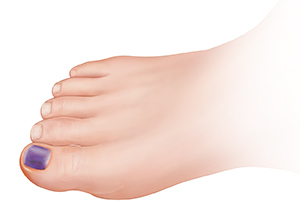Understanding Black-and-Blue Nails
The big toe is the one most often injured resulting in a black-and-blue nail. Bruised, broken blood vessels cause the black and blue colors under the nail. If you had a sudden injury, your toe can be very painful.

How are black-and-blue nails diagnosed?
Your healthcare provider will talk with you about your symptoms and physical activities. They may press the area at the end of the toe to determine the extent of pain. Your toe and foot will be examined for any signs of infection. If a fracture or a bone spur is suspected, X-rays may be needed. If small black spots are present under the nail, other problems may need to be ruled out.
Treatment for black-and-blue nails
If your pain is severe, your healthcare provider may remove the nail. Or they may drill a hole in the nail to let the fluid drain from underneath. This relieves the pressure. A local anesthetic may be used first. Pain may also be relieved with prescription medicines. Soaking or icing the area may also help. If pain is not severe, you may not need treatment. The nail can be thinned or left alone to fall off on its own. A new nail should grow to replace it.
Preventing black-and-blue nails
You can prevent many nail problems by wearing the right shoes and trimming your nails properly. To help prevent infection, keep your feet clean and dry. If you have diabetes, talk with your healthcare provider before doing any foot self-care.
-
The right shoes. Get your feet measured (your size may change as you age). Wear shoes that are supportive and roomy enough for your toes to wiggle. Look for shoes made of natural materials such as leather, which let your feet breathe.
-
Proper trimming. To prevent problems, trim your toenails straight across without cutting down into the corners. If you can’t trim your own nails, ask a healthcare provider to do so for you.